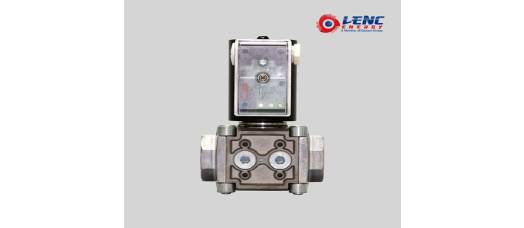Principle and Maintenance of Solenoid Valve
The Solenoid Valve is composed of a solenoid coil and a magnetic core, and is a valve body containing one or several holes. When the coil is energized or de-energized, the operation of the magnetic core will cause the fluid to pass through the valve body or be cut off to achieve the purpose of changing the direction of the fluid. The electromagnetic part of the solenoid valve is composed of fixed iron core, moving iron core, coil and other parts; the valve body part is composed of spool valve core, spool valve sleeve, spring base, etc. The solenoid coil is directly installed on the valve body, and the valve body is enclosed in a sealed tube, forming a simple and compact combination.
In principle, solenoid valves are divided into three categories
From the gas or oil circuit, the solenoid valves we commonly use in production include two-position three-way, two-position four-way, two-position five-way, etc. The two-position solenoid valve means that the spool of the solenoid valve has two different working positions. And how many channels refer to the number of passages on the valve body of the solenoid valve; for example, the two-position two-way solenoid valve has one in and one out, and the two-position three-way solenoid valve controls the liquid to be one in and two out; the pneumatic reversing solenoid valve is one in One exhaust and one exhaust; hydraulic pressure one in, one out and one oil return.
The following briefly introduces the more common two-position five-way solenoid valve:
The Two-Position Five-Way Solenoid Valve is generally double electric. The principle of operation of the two-position five-way double electronically controlled solenoid valve: when the positive-acting coil is energized, the positive-acting gas circuit is connected. Even if the positive-acting coil is de-energized, the positive-acting gas circuit is still connected and it will be maintained until Until the reaction coil is energized. When the reaction coil is energized, the reaction gas circuit is connected. Even if the reaction coil is powered off, the reaction gas circuit is still connected, and it will be maintained until the positive operation coil is energized. This is equivalent to "self-locking". Based on the characteristics of the two-position five-way dual electronically controlled solenoid valve, when designing the electromechanical control circuit or programming the PLC program, the solenoid valve coil can be operated for 1 to 2 seconds, so as to protect the solenoid valve coil from damage.

Solenoid Valve
Common troubleshooting
The fault of the solenoid valve will directly affect the action of the switching valve and the regulating valve. It should be checked from the following aspects:
(1) The solenoid valve coil is burned out
The reason is that the coil is damp, causing poor insulation and magnetic leakage, causing excessive current in the coil and burning. Therefore, it is necessary to prevent rainwater from entering the solenoid valve. In addition, if the spring is too hard, the reaction force is too large, the number of turns of the coil is too small, and the suction force is not enough to cause the coil to burn. For emergency treatment, you can turn the manual button on the coil from the "0" position to the "1" position during normal operation to open the valve.
(2) The solenoid valve is stuck.
The matching clearance between the valve sleeve of the solenoid valve and the valve core is very small. Generally, it is a single-piece assembly. When mechanical impurities are brought in or there is too little lubricating oil, it is easy to jam. The treatment method can be made by inserting a steel wire through a small hole in the head to make it rebound. The fundamental solution is to remove the solenoid valve, take out the valve core and valve core sleeve, and clean it with CCI4 to make the valve core move flexibly in the valve sleeve. When disassembling, pay attention to the assembly sequence of each component and the position of external wiring, so that the reassembly and wiring are correct, and check whether the oil spray hole of the lubricator is blocked and whether the lubricating oil is sufficient.
(3) Air leakage.
Air leakage will cause insufficient air pressure, making it difficult to open and close the forced valve. The reason is that the sealing gasket is damaged or the slide valve is worn, which causes blow-by in several cavities. When dealing with the solenoid valve fault of the switching system, the appropriate time should be selected, and the solenoid valve should be dealt with when the solenoid valve is de-energized. If the processing cannot be completed within a switching gap, the switching system can be suspended and handled calmly.
If necessary, please contact the Solenoid Valve Manufacturer








